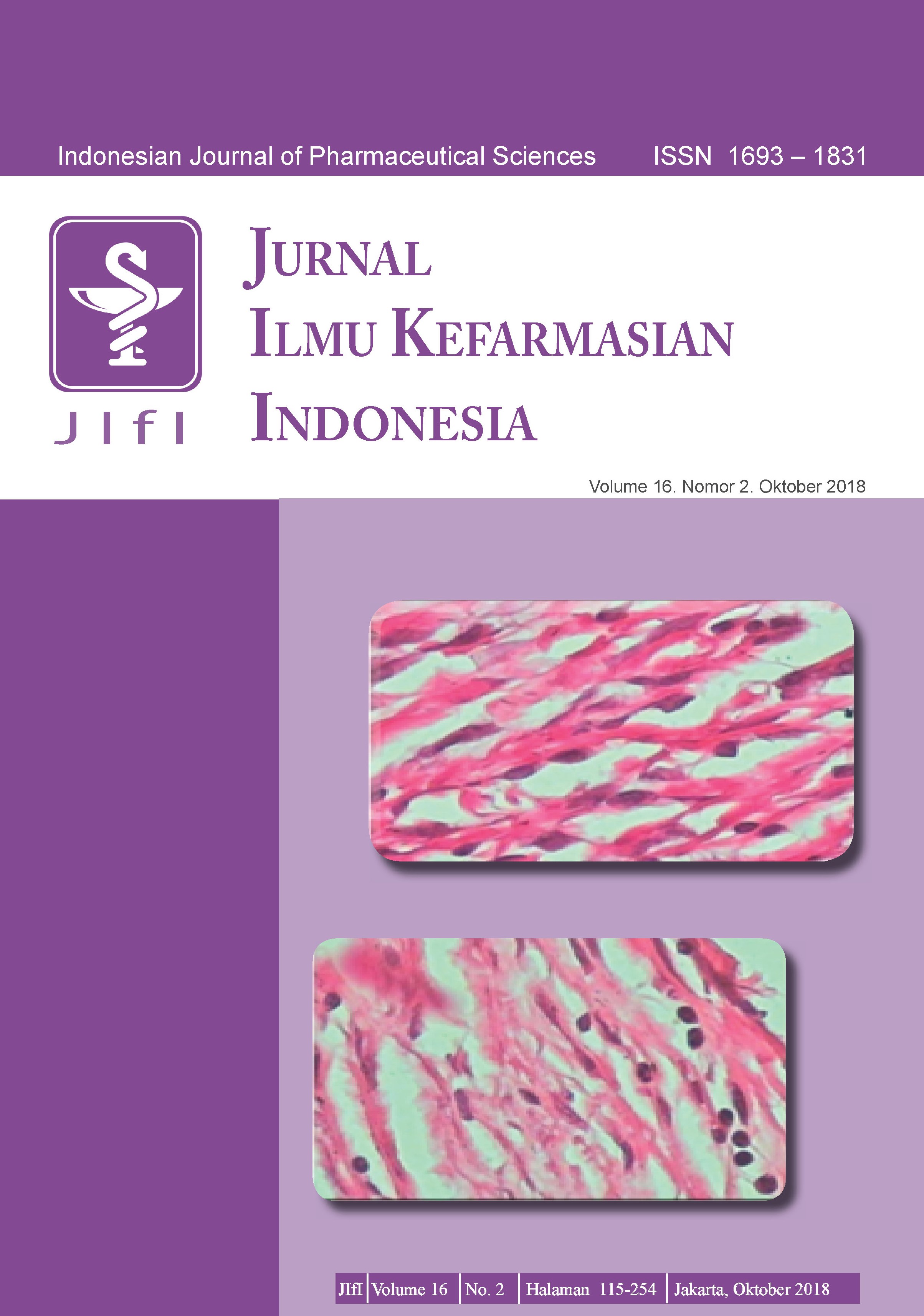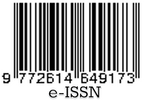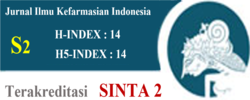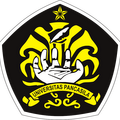In Vitro Enzyme Tyrosinase Inhibitory Activity Test on Liquorice Root Extract Cream (Glycyrrhiza glabra L.)
Abstract
Liquorice root extract (Glycyrrhiza glabra L.) contains glabridin, an isoflavone substance that has the ability to inhibit the oxidation of L-tyrosin and L-DOPA in the formation of melanin, therefore it can be used as skin whitening. The aim of the study was to determine the potential of the best skin whitening cream using positive control of kojic acid. Formulated 1 blank formula, 3 cream formulas using various concentrations of ethanol extract 70% liquorice roots of (0.01, 0.11, 1.01)% based on the value of tyrosinase inhibition activity in vitro from extracts of (50, 75, 100)%. Spectrophotometric method is used to measure the absorption of dopacrome by a microplate reader which was incubated at 37°C at λ 490 nm for 20 minutes. Oil in water cream was prepared by mixing extract with cream base at a temperature of 70-75°C at a speed of 400 rpm for 25 minutes. Stability test was carried out for 4 weeks at room temperature storage and a temperature of 40°C, evaluated for physical quality. The results of determination of IC50 of kojic acid was 20.88 µg / mL; IC50 of extract variation were (126.75; 1130.90; and 10092.41) µg / mL respectively. Cream has milky white-yellowish color; smell of flowers; soft texture; homogeneous; there is no separation; has type M/A; plastic thixotropic flow properties; has an increasing value including viscosity, spreadability, globule size, and pH, which are respectively (455000-620000)cPs, (2695.82-3545.83)mm2, (54.66-66.27)μm , and (4.44-5.04); tyrosinase inhibition activity in formula 1, 2 and 3 were stored at weeks 0, 2nd and 4th were respectively (1.78; -25.74; 22.04)%, (6.74; 6, 12; 4.49)%, and (-28.78; 53.06; 20.32)%. It can be concluded that the cream formula containing liquorice root extract with a concentration of 1.01% is the best formula so it can be used as skin whitening.
References
2. Jennifer C, Stephie CM. A review on skin whitening property of plant extracts. Bangalore. Int J. Pharm Bio Sci.;2012; 3(4):332 – 47
3. Zuidhoff HW and Van Rijsbergen JM. Whitening Efficacy of Frequently Used Whitenning Ingredients.; 2001; C&T; 116(1): 53-59.
4. Hosseinzadeh H., Nassiri M. Review of pharmacological effects of Glycyrrhiza sp. and its bioactive compounds. Wiley InterScience; 2008;22, p. 709–724
5. Vispute S, Khopade A. Glycyrrhiza glabra Linn IJPBS.; 2011; 2; p. 43
6. Zadeh JB, Kor ZM, Goftar MK. Licorice (Glycrrhiza glabra Linn) As a Valuable Medicinal Plant. International Journal of Advanced Biological and Biomedical Research;2013;1(10):1281-88
7. Tian M., Yan H., Row KH. Extraction of Glycyrrhizic Acid and Glabridin from Licorice. International Journal of Molecular Sciences; ISSN 1422-0067; 2008.
8. Zongping Z. Isolation and structural elucidation of tyrosinase inhibitors from five plant extracts (thesis). Hongkong:The University of Hongkong; 2011.
9. Chang, T.S. An updated review of tyrosinase inhibitors. Department of Biological Science and Technology. National University Tainan Taiwan; 2009.
10. Batubara I, Darusman LK, Mitsunaga T, et al. Potency of Indonesian medicinal plants as tyrosinase inhibitor and antioxidant agent. J. Bio. Sci., 2010;10(2): 138 144.
11. Departemen Kesehatan Republik Indonesia. Parameter Standar Umum Ekstrak Tumbuhan Obat Jakarta. Direktorat Jenderal Pengawasan Obat dan Makanan;2000; h. 5,10-11.
12. Barel AO, Poye M, Maibach HI. Handbook of cosmetic science and technology. New York: Marcel Dekker, Inc; 2002.
13. Harry RG. Stability Modern Cosmeticology. Edisi VIII. New York: Chemical Publishing Co, Inc; 2000.
14. Ansel HC. Pengantar bentuk sediaan farmasi. Edisi keempat. Diterjemahkan oleh: Ibrahim F. Jakarta: UI Press; 2008; h.376-89.
15. Rowe C, Sheskey J, Quinn E. Handbook of Pharmaceutical Excipients Sixth Edition. London: American Pharmaceutical Association;2009. p. 75, 155, 283, 290-91, 378-9, 441-2, 445-6, 549-52, 592, 596, 766
16. Sinko PJ. Farmasi Fisik dan Ilmu Farmasetika Martin, edisi kelima. Diterjemahkan oleh Djajadisastra J. dari Martin’s Physical Pharmacy and Pharmaceutical Science, Jakarta: UI Press; 2011.
17. The Departement of Health of Great Britain. British Phamacopeia. London: The Stationary Office; 2009. p. A27, 962, 1334, 1557, 1658, 1729-30, 1922, 1942, 2154.
Licencing
All articles in Jurnal Ilmu Kefarmasian Indonesia are an open-access article, distributed under the terms of the Creative Commons Attribution-NonCommercial-ShareAlike 4.0 International License which permits unrestricted non-commercial used, distribution and reproduction in any medium.
This licence applies to Author(s) and Public Reader means that the users mays :
- SHARE:
copy and redistribute the article in any medium or format - ADAPT:
remix, transform, and build upon the article (eg.: to produce a new research work and, possibly, a new publication) - ALIKE:
If you remix, transform, or build upon the article, you must distribute your contributions under the same license as the original. - NO ADDITIONAL RESTRICTIONS:
You may not apply legal terms or technological measures that legally restrict others from doing anything the license permits.
It does however mean that when you use it you must:
- ATTRIBUTION: You must give appropriate credit to both the Author(s) and the journal, provide a link to the license, and indicate if changes were made. You may do so in any reasonable manner, but not in any way that suggests the licensor endorses you or your use.
You may not:
- NONCOMMERCIAL: You may not use the article for commercial purposes.
This work is licensed under a Creative Commons Attribution-NonCommercial-ShareAlike 4.0 International License.





 Tools
Tools





















